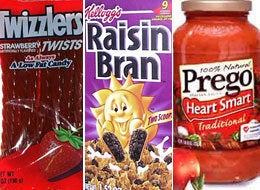
 Fridge watching, fridge voyeurism or whatever you want to call it, is a movement, where people take snapshots of the food inside their fridges for the world to see. It can be a very intimate encounter, revealing so much about a person, and their habits. Especially, how one puts green ideas into practice. Fridge Watcher lets you peak inside fridges from all over the world. And today, I will show you mine.
Fridge watching, fridge voyeurism or whatever you want to call it, is a movement, where people take snapshots of the food inside their fridges for the world to see. It can be a very intimate encounter, revealing so much about a person, and their habits. Especially, how one puts green ideas into practice. Fridge Watcher lets you peak inside fridges from all over the world. And today, I will show you mine.
We are more than what we eat, since food production is a major source of greenhouse gas emissions. From my fridge in Tel Aviv-Jaffa, to the fridge featured here in Jerusalem, you'll see that people in the Middle East, even if it's two examples, tend to eat a lot more fresh foods. Frozen foods might be okay for students, but you'll never sit down to a Moroccan, Persian, or Egyptian's family meal and eat frozen fish sticks!
Since moving from Canada to Israel, my food habits have changed quite a bit. I used to be a fan of frozen dinners. Here, frozen food costs and arm and a leg and it's not very good. My other favorite food, Mexican, is just not common here.
So you want to look inside... sit back, relax and take the tour!
CONTENTS (Door on right): Bio eggs, butter, organic strawberry jam, milk, mustard, sundried tomatoes, pomegranate concentrate, goat's milk yogurt, V8, tehina, capers, guava juice, orange juice, batteries (not for eating!), coconut juice, goat's yogurt, and the old Canadian maple syrup (thanks Mom!).
SOURCE: There are a number of imported items here like the V8 from North America and the juice from Egypt. The jam is from the United States. Phoeey on me, but it looked so good. And the pomegranate concentrate, I think is from Turkey, while syrup is from Canada. All the milk products are produced locally and bought at Eden Teva market or local non-organic shops. Milk costs about $1.50 a liter in Israel (non-organic), the organic yogurt about $3 a bottle.
CONTENTS: (from top to bottom, left to right) organic lentil sprouts that I made, organic goat's cheese, chessick fruit, soft regular white cheese 5%, organic red cabbage part of a weekly CSA veggie box delivery (choose from a list of CSAs here if you live in Israel); more cheese including a Rockfort goat's cheese, Syrian dates, spicy lettuces, cabbage, parsley, green onions, carrots, leaks, tomatoes, radishes, cucumbers, and spinach.
SOURCE: Vegetables come from an organic farm, which delivers a box of whatever's in season, once a week. Some of the cheese is from Eden Teva market, a health food store in Bnei Brak; some cheese is from Arab supermarket on the corner nearby my house. Reducing food miles is important to me from an environmental perspective. I try to eat locally produced food, and things which are in season.
CONTENTS: It being Passover in Israel means that a lot of the bread products you might see here other times of the year have been cleaned out, eaten or burned, as per Jewish custom. Moving on, there is some sort of white fish, hamburger organic and regular, rice (stored in freezer to keep the bugs out), and a strange kind of sheep tail fat (bottom right) for making a Bukharian food known as Osh Pollo. It is wrapped like that because someone (on their request) was supposed to "smuggle" it to the US where no such sheep tail fat can be found. It stays frozen in the meantime. (As a once a week meat-eater, Osh Pollo is very yummy and highly recommended.)
SOURCE: The frozen products come from Eden Teva Market, a health food store, a regular grocery store, and the sheep tail fat, a local market. Normally you won't find so much meat in the freezer, as I tend to buy it when I want it. I have no idea how much meat costs per kilo, because I buy it so rarely. The organic hamburger, enough to feed 4, cost about $25 for the box, times 2 what you see above.
Want to know more about fridge voyeurism? Fridge Watcher is a good place to start.
::Canada's Israel via Green Prophet
More on greening your fridge from TreeHugger:
5 Ways To Green Your Fridge
Could You Unplug Your Refrigerator For Good?
Bottom Freezer Refrigerator Options
